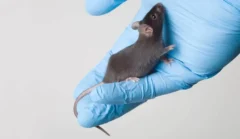
The evolution of mice and rats has been going on independently for 10-20 million years, during which rodents have accumulated many differences, including in the brain. However, this did not prevent the authors of a new article in Cell from creating a mouse in which rat stem cells were introduced at the embryonic stage. They successfully took root, began to work together with mouse neurons and even took over their role in brain damage.
For centuries, people have tried to create chimeras—animals made up of parts of two different species—and have failed every time. However, modern genetic methods have made it possible. Authors of a new article in the magazine Cell were able to obtain a hybrid version of the most complex organ, the brain, by combining mouse and rat cells.
Two species of rodents are among the most popular animals that biologists use in their work. There are significant differences between them, including in the structure and operation of the brain, which is the result of millions of years of independent evolution. For example, rats are much larger and have a finer sense of smell.

The authors used the transplantation of pluripotent stem cells, one of the most promising methods of treatment for many diseases. At the same time, stem cell transplantation is associated with a low risk and has not yet been fully studied. Therefore, biologists decided to find out how foreign cells will behave in the body of another species. For this, they used material from rats, which was transferred to mouse embryos at an early stage of development (blastocysts).
One of the main difficulties in creating a hybrid mouse and rat brain is the different development times of the organ in the two rodents. Indeed, the brain of the rat is larger, has a thicker cortex, and its embryogenesis lags behind that of the mouse by one or two days. However, the experiments were successful: the rat stem cells survived, differentiated into nerves and integrated into the neural networks of the brain mixed with the mouse's own cells. At most, there were even "hybrid synapses" - contacts between neurons from two different species.
The rat cells were widely distributed throughout the hybrid brain, varying from 0,01 percent to about 87 percent in different regions. However, their distribution, which was visualized using a special fluorescent marker, turned out to be asymmetric and strongly differed in the left and right hemispheres.

Next, the scientists checked whether the cells from the rat could take over the work of mouse neurons. For this purpose, the brain regions of mice involved in smell were "turned off" or killed with a selective toxin. This precise effect did not affect the neurons of the rat. It turned out that foreign cells are good at conducting nerve impulses. "Hybrid" mice almost completely recovered their lost sense of smell: this was confirmed by a test in which they dug up a hidden cookie.
The new result sheds light on the behavior of stem cells in the body belonging to a different species. It can be useful for the development of regenerative medicine and transplantology.


 248
248











